FLexible RAdio CoMmunication Optimization FramEwork and Applications (FLAME)
Radio Communication Systems have offered spectacular achievements and opportunities for applications and services in information and communication technologies. These attainments are based mainly on progress in the following fundamental areas: communication and information theory, signal processing and computer and related technologies. The statistical approach to consideration of most problems related to information transmission has become dominant since any real signal, propagation media, interference and even information itself all have an intrinsically random nature. The radio channel/interference statistical behavior is changing over time and is really hard to be predicted as a result of the movement of users and the environment dynamics. In radio communication networks, the reliable communication is constrained by the radio propagation effects, the interference and the noise which are inherently present in all wireless communication systems. An accurate description of such impairments is very important for the design of high reliable and resilient modern radio communication systems. The choice of the relevant channel and interference models are very crucial in the design process and are an important step in their testing and performance evaluation. Another very important technical challenge in modern wireless networks is the integration of the heterogeneous radio access technologies. Accurate radio channel models that will describe unifyingly the space-time variation of the miscellaneous radio links are necessary. The specific communication requirements, that aim to improve the performance of radio systems, are often conflicted and hard to be formulated in a way convenient for optimization. On one side the models that are used for the radio systems performance and evaluation, must accurately reflect the main features of the radio channel and the radio interference under investigation. On the other hand, simple description is required to be applicable for the massive numerical simulations that are necessary to test the performance of complex radio communication systems. In realistic radio communication systems, non-stationary and non- Gaussian radio channel and interference are present. Consequently, simple models fail to represent accurately the time varying phenomena of the radio channel. All of these, coupled with increased complexity of the radio systems (multi-antenna systems -MIMO), multi-user, complex cooperative systems, large scale radio networks etc.) and reduced design time, require simplicity and accuracy for the complete radio communication system.
Moreover, there are many optimization techniques that are mainly based on long-term average perspective of the radio channels and interference. In order to be able to handle the time evolution of the radio channels/interference, new optimized resource allocation schemes must be developed taking into account the time dependency for providing fair and robust outcomes in radio communication systems.
What is missing is a general flexible radio communication optimization framework that could describe accurately the stochastic properties of the radio channel and the radio interference and give exact dynamic information regarding the radio state information that could be used for the optimum radio resource allocation in radio systems. FLAME will develop a stochastic radio framework using multi-dimensional stochastic differential equations (SDEs) and then new flexible optimum radio resource strategies will also be developed. More specifically, FLAME’s scientific contribution is firstly a general approach for the dynamic radio channel/interference continuous modeling in heterogeneous radio access technologies and their accurate description through stochastic differential equations. Secondly, taking into account the flexible radio communication framework and relying on dynamic game theory (stochastic and evolutionary games) andother dynamic algorithmic approximations (e.g. optimal stopping theory), FLAME develops new radio resource allocation algorithms in complex radio networks.
FLAME Objectives
The FLAME aims at the fulfillment of the following objectives:
- Development of a stochastic dynamic radio channel framework based on Stochastic Differential Equations in order to capture the spatio-temporal dynamics of the wireless signals of a radio communication system.
- Address the heterogeneous radio environment using a flexible unified stochastic radio framework with SDEs to describe accurately the joint spatio-temporal variations.
- Development of systems of stochastic differential equations for modeling correlated composite channels that include large and small scale effects and obtain their analytical solutions.
- Development of a general stochastic dynamic model for the space-time variations of the radio aggregate interference, making several assumptions regarding the multiple receivers and the correlation of the fading channels.
- Proposal of new dynamic games to develop novel algorithms with time varying solutions to the resource allocation problems of complex radio systems.
- Proposal of new dynamic optimum algorithmic solutions for radio resources allocation based on temporal optimization using optimal stopping theory.
- Investigation of the radio communication systems trade-off taking into account the high quality-of- service requirements of modern wireless applications.
- Development of new analytical models for the performance’s evaluation of complex radio networks and novel optimum communication protocols of complex radio networks.
- Investigation of novel energy efficient transmisssion schemes and exploration of their integration in stochastic radio channel/interference optimization framework.
- Provision of accurate simulation tools for investigating the effect of system parameters on modern radio communication systems (IEEE 802.11, IEEE 802.16, LTE, hybrid satellite/terrestrial DVB-SH etc) performance in challenging radio environments.
Technical Description –Methodology Work Plan
FLAME activity is divided in the following five Work Packages (WPs). Their interaction is shown in Fig.1. WP1 and WP5 are devoted to administration and dissemination activities respectively. WP2 and WP3 are the main technical packages that provide the theoretical background of FLAME, a new flexible radio communication optimization framework. WP4 serves as a means for validating and consolidating the results in complex radio networks. Below the technical WPs are divided in Tasks and the research methodology is analytically presented. The duration of FLAME is 26 months.
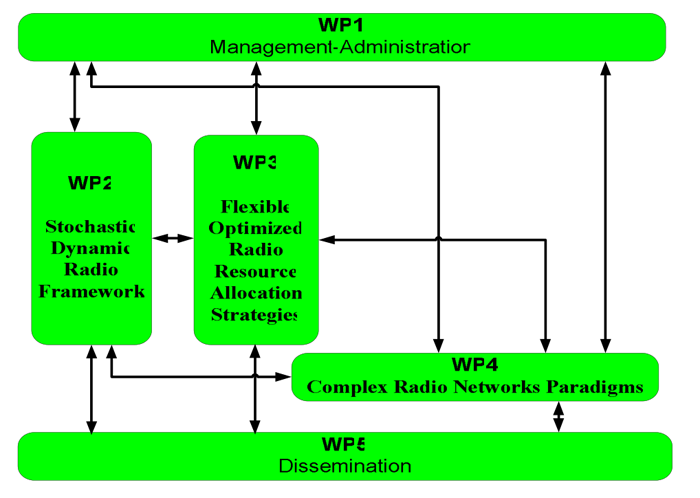
Interaction between the WPs
WP1: Management/Administration (T0-M26)
Principal Investigator (PI) Prof. Panagopoulos has great experience in the technical execution and management of research projects. PI Prof. Panagopoulos will be strongly committed to FLAME and will devote most of his time to FLAME project. PI will also be the leader in all the WPs and all the Tasks. He will keep daily contacts with the other Investigators (including the Post-doc researchers and the PhD students) to ensure that the project directions and objectives are maintained; he will be responsible for all the publications, the deliverables and will maintain accurate records of costs, resources for the project and finally he will co-ordinate the preparation of reports and ensure their delivery to the Ministry of Education.
WP2: Stochastic Dynamic Radio Framework (T0-M26)
Task 2.1: Stochastic Radio Channel Modeling Framework (T0-M26)
The radio channels of multiple links in general are modeled using stochastic differential equations and various models are developed taking into account the propagation in different environments (urban, suburban, rural, indoor etc). Gaussian and non-gaussian channels are investigated in this Task. The essence of this methodology is to describe the radio channels as stochastic processes, meaning as a solution of multi- dimensional SDEs that can be synthesized based on some a priori information (such as marginal distributions and correlation functions). This procedure uncovers the joint hidden dynamics of the radio channels, which are necessary for the performance optimization of the radio communication system under consideration. The long-term characteristics of the multiple links (belonging to different radio access technologies in general), i.e. shadowing and multipath fading, are firstly investigated theoretically. Secondly, the problem of the time dependence of shadowing, and the power spectrum and/or time dependence of multipath fading concerning the Doppler effect and the spatial dependence (angular selectivity), are examined through an extensive bibliographical research. The relevant propagation measurement campaigns for the multi-dimensional modeling will be studied.
Using the joint long-term distributions and taking into account either the time correlation of the fading or the space correlation or both of them, systems of SDEs are developed for all the channel’s components , making possible the generation of correlated time series of the radio channels.
Here we have to note, that our modeling is either in the envelope level and the corresponding phase component or in SNR level. The correlation between shadowing and multipath fading is also taken under consideration in the channel models, therefore resulting in multidimensional SDEs. From their solutions, analytical expressions for simulating accurate time series are delivered and new very useful expressions regarding the transition probability density functions and the hitting time statistics are derived. Moreover, the frequency selectivity will also be considered and therefore the modeling of wideband and narrowband channels will be investigated. This is achieved by using the concept of multidimensional SDEs for modeling each one of signal’s delay components and either adopting a spatial correlation for correlated scattering or considering them as independent for the case of uncorrelated scattering. As a final step in this task, the proposed stochastic radio channel modeling framework deals with the problem of space-time variations of the channel that is a very critical point in current multi-antenna radio systems, MIMO and virtual MIMO. Thus, new multidimensional SDEs will be developed in order to generate time series of the MIMO channels for correlated or uncorrelated paths. The suggested radio channel framework suits very well for computer simulations and it is universal since a single structure allows the modeling of a great variety of different processes by a simple variation of the system parameters and excitations.
Task 2.2: Radio Interference Dynamic Stochastic Modeling (T0-M26)
This Task aims at stochastic dynamic modeling of the aggregate radio interference in radio communication systems. This leads to the fact that radio interference will be seen as a stochastic process and a solution of a SDE. To be more specific, radio interference in this Task will be modeled as space-time random field and the solution of SDE will lead to an accurate time series synthesizer. In the beginning of this task, the long-term statistical distributions and properties of the radio network interference will be generally modeled, starting from the novel mathematical framework presented in the state-of-the-art section. For modeling the radio interference, the network geometry and the propagation effects will be needed. Therefore, the identification of the spatial distribution of the transmitters (e.g. Poisson process, random walk mobility model, etc) as well as the modeling of propagation effects such as path loss, shadowing and multipath fadingwill be needed. Using the concept of correlated or uncorrelated scattered nodes, the probability density function of the aggregated interference will be derived and categorized in different classes for the stochastic network geometries and long-term statistics of propagation effects. After the calculation of the probability density function of the network interference and its categories, the problem of the space-time dependence of interference will be addressed with the adoption of space-time correlation functions for two cases: a) various individual interfering nodes and b) a unique space-time correlation function for the aggregate interference distribution. The necessity of these two different approaches that lead to two different synthesizers comes from the fact that the first one is more accurate but more complex than the second. Therefore, depending on the trade-off between accuracy and the calculation time, different applications may use different synthesizers. In the first case, models examined in the previous Task for the autocorrelation and the generation of time series for shadowing and multipath fading will be also used in this task. Since the interference is the sum of the radio signal from all the interfering nodes then multidimensional SDEs will also be used for the generation of the time series of every single interfering signal. For the second case, the model for generating time series of the interference will also be developed using SDEs to model the network interference as a unique stochastic process. The stochastic dynamic model of radio aggregate interference will have numerous applications in cognitive radio networks, in wireless packet networks and the coexistence between ultrawideband and narrowband radio communications systems.
WP3: Flexible Optimized Radio Resources Allocation Strategies (T0-M26)
Task 3.1 Optimization Framework of Dynamic Radio Systems using Game Theory (T0-M26)
This Task aims to propose an optimization framework for dynamic radio systems. Radio channels are highly dynamic, resulting in time varying characteristics of the basic telecommunication parameters SNR, SINR etc. In order to be able to handle this information efficiently, the optimized resource allocation techniques should be inherently adaptive to the highly dynamic network channel conditions. These techniques have also to take into account the time-correlation of the channel dynamics so as to optimize both long-term and short-term radio system’s performance. Evolutionary algorithms based on game theory as well as bio-inspired resource allocation mechanisms are promising tools for providing fair, robust and adaptive outcomes in wireless networks where the network conditions evolve dynamically. In this Task exploiting some radio parameters that changein space and time and their predicted values from the WP2, the stochastic/sequential games will be properly modified so as to lead to novel resource allocation algorithms. The utility functions will vary in time following radio characteristics of the wireless users. These games will provide a more realistic setting for real radio systems because the wireless users are dynamic players that confront time varying radio environment continuously, make predictions about future state conditions and respond dynamically, taking into account the present and future actions of other players. In this way, the stochastic dynamic optimization framework will permit the design of dynamic competition between the users. Moreover, another evolutionary approach which belongs to the dynamic game framework and it will bestudied in this Task is the evolutionary coalition approach. This class of game dynamics requires less information compared to the standard game approaches.In this task, the resulting payoff of the coalition participants will be investigated using either the dynamical Shapley value either other time-varying imputation procedures. FLAME’s goal is also the development of fully new distributed algorithms in which the radio communication system users adapt their strategies in an iterative fashion even without knowing the mathematical expression of their utility function and taking into account their channel conditions and their transmission schemes. Finally, the recently bio-inspired allocation techniques will be examined and appropriately modified integrating the radio channel and the radio interference time dynamics in these algorithms making them more efficient.
Task 3.2 Dynamic Optimization Framework using Optimal Stopping Theory (T0-M26)
In order to adapt to the spatio-temporal varying of radio quantities, various schemes have been proposed in the literature. However, current schemes along this line are designed for specific applications and are based on heuristics, implying room for performance enhancement. The primary goal of this Task is to provide a holistic temporal optimization framework that exploits the stochastic evolution formulating sequential decision problems based on optimal stopping theory which provides a solid theoretical foundation for designing such schemes. Optimal stopping problems are dynamic optimization problems, where a decision maker observes a sequence of random variables, given their long-term joint probability distribution and associated real-valued reward functions under conventional settings. The solution for optimal stopping problems consists of the time instant at which the supremum or infimum of an objective function is attained. More specifically, a cost function may be associated with running the stochastic process. In addition, there may be a reward function, dependent on the level of the process, which will be realized upon termination of the process. These two functions are incorporated into the gain or payoff function and it is desirable to maximize the payoff, i.e., to get the maximum reward at minimum cost. In the proposed framework, we will focus on the lower layers where some of the objective functions that need to be optimized are the throughput, the rate/Joule, the transmission power, the battery lifetime, the SINR, the BER, the end-to-end delay etc. Due to the holistic optimization perspective of the proposed framework, we will assume in the following a general utility function that without loss of generality needs to be maximized and might be one of the above objective function or a combination of them that will also takes into account fairness requirements and other criteria, depending on the considered scenario. Furthermore, this general utility function can also be formulated following the next two perspectives: an individual radio centric perspective (e.g. individual user’s throughput, individual user’s battery) and a network centric perspective (e.g. aggregate or overall network’s throughput, total network’s lifetime). The problem is to choose the best time to stop so as to maximize the expected utility function. Building on optimal stopping theory, sometimes in practice may be more appropriate to cast the problem as a maximization problem of the average utility function or a performance metric per unit of time (named as rate of return). Thus, due to large number of the possible optimization goals and scenarios, the prime and ultimate aim of the proposed framework will be its fundamental and holistic nature that forces us to divide it into two general optimization categories: a) the classical optimal stopping problems, which optimize the expected utility function,, and b) the rate of return optimal stopping problems, which optimize the average utility function per unit of time. Problems from both categories can be either of finite or infinite horizon and the optimality equation can be used for the solution of them introducing significantly high complexity for the second category problems. Finally, in this Task, FLAME’s goal is to adjust the more common time optimization problems in wireless communications and boil them down to judiciously choosing unified optimal stopping rules that will yield from the proposed framework. As a result, there will be produced tradeoffs between stopping at a given time instant and continuing in order to stop latter in hope for a better reward that will also give an additional overhead. Intuitively speaking, if the overhead continuing is overwhelming, the reward may not be worthwhile. Thus, the purpose of the proposed framework is this tradeoff to be balanced using optimal stopping theory.
WP4: Complex Radio Communication Systems Paradigms
Task 4.1: Experimental Measurement Campaign: Validation and Exploitation (M7-M26)
This Task aims to present innovative radiochannel measurements for complex radio systems. These measurements will be used as the parameters of the stochastic radio channel modeling framework. A promising approach to obtain insights of the various propagation channels is to perform impulse response measurements. The goal of this experiment is to perform narrowaband/wideband measurements in challenging environments (urban, indoor, vehicle-to-vehicle etc.). Essential parameters that require characterization are the path loss, and the time-dispersion of the channel, as well as its spatial distribution, depending on the various examined frequencies, and receiver locations. The measurements will be performed at 2.4 and 5.2GHz, which are the well-known ISM bands. The transmitter will be placed in various distances and spatial points in order to evaluate the spatial distribution of the signal power. The measurement system is comprised of a Vector Network Analyzer (VNA) utilized to measure the S 21 parameter between the transmitter antenna and the receiver antenna (mobile terminal). From the channel impulse response, the time- dispersion parameters will be extracted and modelled. The time-dispersion parameters are the mean excess delay, the maximum excess delay, and the rms delay spread. The spatial distribution of the signal power will also be derived from the statistical process of the measurements. Moreover, the radio dynamics can be simulated using advansed computatational electromagnetic techniques (time-domain analysis to channel modeling). Additionally in this Task, we intent to implement real radio communication systems and to evaluate algorithms regarding cooperative strategies, scheduling, channel estimation and energy effient transmission techniques.
Task 4.2 Novel Analytical Models of Complex Radio Networks Performance (M7-M26)
Modern radio communications have to support increased throughput and therefore combat the channel fading and the interference from other wireless devices, to be green, i.e. to minimize the power consumption, to be efficient by cleverly using the radio and the computing resources and to be flexible, i.e. to effectively adapt to the fast changing radio environment. In this Task, novel analytical models concerning the performance of modern complex radio networks will be derived. Different communication techniques and protocols will be investigated, such as cooperative radio, cognitive radio, Multiple-Input Multiple- Output (MIMO) techniques, relaying and space-time coding. Modern radio systems will be considered, e.g. Small Cell networks, urban cooperative networks and hybrid satellite-terrestrial systems. Small Cells and Macro Cells work in tandem, creating a flexible heterogeneous network which connects to the mobile operator’s backhaul and offers services to mobile nodes with increased efficiency and capacity. A very interesting complex radio network is the employment of mobile gap-filler in hybrid satellite/terrestrial networks. In this scenario, the land mobile users cooperate with those with very good channel conditions in order to access interactive services broadcasted by the satellite platform. The performance of these complex radio networks will be evaluated in terms of various communication metrics, such as outage probability, bit- error rate, Shannon capacity and overall throughput. The analytical models that will be proposed will incorporate the stochastic channel modelling of WP2 and the optimization techniques of WP3. Therefore, this analysis will lead to the optimum design of complex radio networks while meeting the performance requirements (quality-of-service) and to the optimum trade-off among the system parameters and the performance metrics. In this Task, an accurate Simulation Tool will be developed in order to validate the analytical results and to incorporate the experimental data of the Task 4.1. Extended simulations will be conducted, while parameters such as the energy and the spectral efficiency, the architecture and the complexity of the system, the multiple access protocols and the signal processing techniques will be taken into account and the effect of their choice on the overall network performance will be investigated. In addition, the Tool that will be developed will accurately simulate both the fading environment and the communication protocol derived analytically, which leads to the optimum radio communications systems design. The simulations will be used to investigate whether and under which conditions, cooperation is of benefit over non-cooperation, how the nodes of a flexible radio network should adapt to the fast changing environment and how the nodes of different systems could coexist and meet their performance requirements at the same time.
WP5: Dissemination (T0-M26)
This WP aims at the dissemination of the scientific results to the wireless and radio communications community (academia and industry) and their possible practical application. WP5 has the following activities: Contributions to standardization groups (ETSI, ITU-R, DVB); Publication and Dissemination of the results in European COST Actions IC1004, IC0902, IC0906; Development of a web site for FLAME; Publications in Peer Reviewed Journals and Conference Proceedings (the most prestigious Journals (IEEE TCOM, IEEE TWC, IEEE TAP, IEEE CL, IEEE TSP, IEEE TVT etc.) and conferences). Finally, special issues will be proposed in the above Journals and convened sessions in the conferences will be organized; Diploma and PhD Thesis Supervision: Young students from NTUA, AUTH will carry out their theses in the frame of the activity. Moreover, many scientific results of FLAME will be disseminated through their inclusion in the syllabus of the undergraduate and postgraduate courses (such as Radio Communication Systems, Mobile Communications, Wireless Communications, and Digital Communications etc). The radio background acquired by the students working on these topics may also be used for applying for internships and training ships in relevant research institutes in Europe and USA.
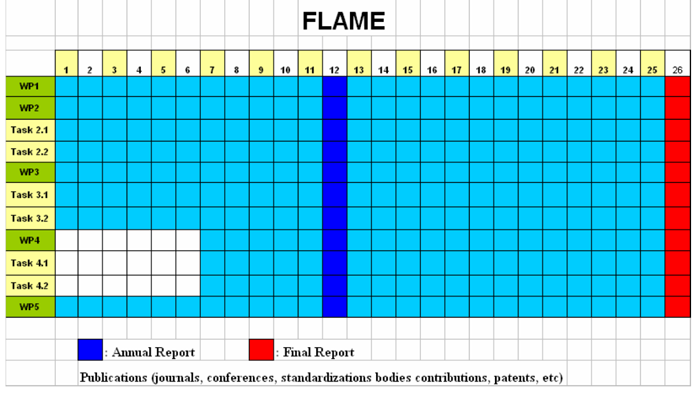
Gantt Diagram
Publications
Journal publications:
- Vassaki, Stavroula, et al. "QoS-Driven Power Allocation Under Peak and Average Interference Constraints in Cognitive Radio Networks." Wireless Personal Communications (2014): 1-26.
- Poulakis, Marios I., et al. "QoS‐driven spectrum sharing game in cognitive radio systems: a variational inequality approach." Transactions on Emerging Telecommunications Technologies (2014).
Conference publications:
- Kourogiorgas, Charilaos and Athanasios D. Panagopoulos. “Interference Statistical Distribution for Cognitive Satellite Communication Systems Operating above 10GHz.”, 7th Advanced Satellite Multimedia Systems Conference (ASMS) 2014, Livorno, September 2014,
- Kourogiorgas, Charilaos and Athanasios D. Panagopoulos. “Application of Stochastic Differential Equations for the Performance Evaluation of Broadband Satellite Communication Systems”, 31st URSI General Assembly and Scientific Symposium 2014, Beijing, China, August 2014
- Vassaki, Stavroula, Marios Poulakis, and Athanasios D. Panagopoulos. "Game-theoretic Spectrum Trading Mechanism for Cognitive Radio Networks." European Wireless 2014; 20th European Wireless Conference; Proceedings of. VDE, 2014.
- Pitsiladis, Giorgos T., Charilaos I. Kourogiorgas, and Athanasios D. Panagopoulos. "Connectivity Evaluation in Random Wireless Multihop Networks under Inverse Gaussian Shadowing Channels." European Wireless 2014; 20th European Wireless Conference; Proceedings of. VDE, 2014.
Book chapter publications:
- Athanasios Panagopoulos, "Accurate and Reliable Simulation Framework for Mobile Computing Systems using Stochastic Differential Equations”, in “Simulation Technologies in Networking and Communications: Selecting the Best Tool for the Test", CRC Press.
Research Team
Principal Investigator
 |
Athanasios D. Panagopoulos (S’98, M’02, SM’09): was born in Athens, Greece on January 26, 1975. He received the Diploma Degree in Electrical and Computer Engineering (summa cum laude) and the Dr. Engineering Degree from National Technical University of Athens (NTUA) in July 1997 and in April 2002. From May 2002 to July 2003, he served the Technical Corps of Hellenic Army. In September 2003, he joined School of Pedagogical and Technological Education, as part-time Assistant Professor, up to June 2008. From January 2005 to May 2008, he was Head of the Satellite Division of Hellenic Authority for the Information and Communication Security and Privacy. From May 2008 to May 2013 he was Lecturer in the School of Electrical and Computer Engineering of NTUA and now he is Assistant Professor. He has published more than 120 papers in international journals and more than 150 papers conference proceedings. He has also published more than 25 Book Chapters in International Books. He is the recipient of URSI General Assembly Young Scientist Award in 2002 (Commission F) and 2005 (Commission C). He is co-recipient of the Best Paper Award in the 2006 IEEE Radio and Wireless Symposium. His research interests include radio communication systems design, mobile computing technologies, wireless and satellite communications networks and the propagation effects on multiple access systems and on communication protocols. He participates to ITU-R and ETSI Study Groups, he is member of Technical Chamber of Greece and Senior Member of IEEE. He is Chairman of the IEEE Greek Communication Chapter. He serves on the editorial boards of International Journal of Antennas and Propagation and Elsevier Physical Communication. Finally, he is an Associate Editor of IEEE Transactions on Antennas and Propagation and an Associate Editor in IEEE Communication Letters. |
Prof. of Aristotle University of Thesaloniki (AUTH)
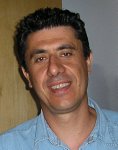 |
George K. Karagiannidis (SM’2003) was born in Pithagorion, Samos Island, Greece. He received the University Diploma (5 years) and Ph.D degree, both in electrical and computer engineering from the University of Patras, in 1987 and 1999, respectively. From 2000 to 2004, he was a Senior Researcher at the Institute for Space Applications and Remote Sensing, National Observatory of Athens, Greece. In June 2004, he joined the faculty of Aristotle University of Thessaloniki, Greece where he is currently Professor and Director of Digital Telecommunications Systems and Networks Laboratory. His research interests are in the broad area of digital communications systems with emphasis on communications theory, energy efficient MIMO and cooperative communications, cognitive radio, smart grid and optical wireless communications. He is the author or coauthor of more than 240 technical papers published in scientific journals and presented at international conferences. He is also author of the Greek edition of a book on “Telecommunications Systems” and co-author of the book Advanced Wireless Communications Systems (Cambridge Publications, 2012). He is co-recipient of the Best Paper Award of the Wireless Communications Symposium (WCS) in the IEEE International Conference on Communications (ICC’07), Glasgow, U.K., June 2007. Dr. Karagiannidis has been a member of Technical Program Committees for several IEEE conferences such as ICC, GLOBECOM, VTC, etc. In the past he was Editor for Fading Channels and Diversity of the IEEE TRANSACTIONS ON COMMUNICATIONS, Senior Editor of IEEE COMMUNICATIONS LETTERS and Editor of the EURASIP Journal of Wireless Communications and Networks. He was Lead Guest Editor of the special issue on “Optical Wireless Communications” of the IEEE JOURNAL ON SELECTED AREAS IN COMMUNICATIONS and Guest Editor of the special issue on “Large-scale multiple antenna wireless systems”. Since January 2012, he is the Editor-in Chief of the IEEE COMMUNICATIONS LETTERS. |
Post-doc Researchers
 |
Georgios T. Pitsiladis received the Diploma degree in electrical and computer engineering from the National Technical University of Athens (NTUA), Athens, Greece, in 2006. In December 2012, he received the Dr.-Ing. degree from the NTUA. He was member of the development team of “Pedion24”, an electromagnetic radiation monitoring network installed in Greece. Mr. Pitsiladis is a Member of the Greek Technical Chamber (TEE). His research interests include connectivity, modeling of wireless broadband multi-hop networks and high frequencies propagation models. |
 |
Stavroula Vassaki was born in Athens, Greece on January 7, 1984. She received the Diploma Degree in Electrical and Computer Engineering from the National Technical University of Athens (NTUA) in October 2006 and the Master degree from the National & Kapodistrian University of Athens in October 2008. In September 2013, she received the Dr.-Ing. degree from the NTUA. Her research interests are in the area of wireless communications and include resource management, cooperative communications, broadband communications, game theory and optimization theory. |
Research Engineers
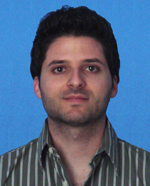 |
Poulakis Marios was born in Athens in 1983. He received the Diploma degree in Electrical and Computer Engineering (ECE) from the National Technical University of Athens (NTUA), Greece, and the M.Sc. degree in Economics and Administration of Telecommunication Networks from the National and Kapodistrian University of Athens, Greece, in July 2006 and December 2008, respectively. In May 2014, he received the Dr.-Ing. degree from the NTUA. Since 2007, he has been an Associate Researcher / Project Engineer with the Mobile Radio Communications Laboratory, ECE, NTUA, participating in various industry and research-oriented projects. Moreover, he has teaching assistant experience in undergraduate courses of ECE, NTUA. From August 2009 to January 2011, he was an RF Engineer with the Non-Ionizing Radiation Office, Greek Atomic Energy Commission, Athens. His research interests include wireless and satellite communications as well as cognitive radio networks with emphasis on optimization mechanisms for quality of service driven scheduling and resource management. He has published 7 papers in international journals, 9 papers in conference proceedings and 2 book chapters. He has very good knowledge of English and several programming languages such as C, Java, JSP, Javascript, SQL, HTML, PHP, MatLab, Mathematica and LaTEX. He has been a Member of the Technical Chamber of Greece since 2007 and Member of IEEE since 2011. |
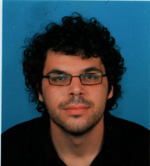 |
Charilaos I. Kourogiorgas was born in Athens, Greece, on July 6, 1985. He received the Diploma Engineering in electrical and computer engineering from the National Technical University of Athens (NTUA), Athens, Greece, in 2009. From October 2009 to June 2011 he was with Department of Electromagnetism and Radar at Office National d’Études et de Recherches Αérospatiales (ONERA), Toulouse, France. He is currently working toward his PhD at NTUA on the subject “Channel modeling for high data-rate wireless terrestrial and satellite communications” under the supervision of Prof. Athanasios Panagopoulos and Prof. John Kanellopoulos. He is participating at COST Actions IC0802 and IC1004. He is a student member of IEEE and a member of Technical Chamber of Greece. His research interests are channel modeling for satellite and terrestrial communication systems. He has 1 publication at an international journal, 9 publications on international conferences, 3 contributions at COST Action IC0802 and he has participated in 5 book chapters |
PhD students
Saggriotis Stavros
Roumeliotis Argyris


